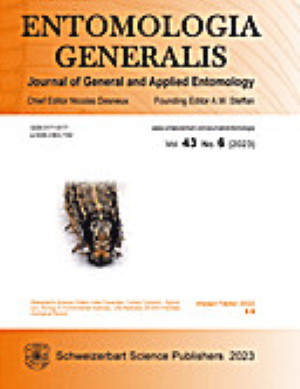Bioengineering plant volatile emissions: prospects for plant protection against insect herbivores
IF 4.6
1区 农林科学
Q1 ENTOMOLOGY
引用次数: 0
Abstract
Genetically engineered crop plants for enhanced emission of herbivore-induced plant volatiles (HIPVs) offer great potential in reducing the herbivore load on crops by repelling insect herbivores directly or attracting their natural enemies. Plant volatile organic compounds (VOCs) are also essential for pollination, insect reproduction, allelopathy, and serve as antimicrobial agents. Existing research in this field revolves around the routine chemical ecological experiments like identifying VOCs, HIPVs, and synthetic blends. Therefore, a deeper understanding of the role of enhanced volatile emissions and volatile biosynthetic pathways involved in chemical communication can lead to the development of behavior-based novel pest management strategies and lay the foundation for future research in these approaches. Recent discoveries in identifying and isolating the enzymes and genes associated with the biosynthetic pathways of volatiles have opened new avenues for the genetic engineering of crops. Genetically engineered plants could be developed to release volatiles only with an herbivore attack to conserve plant resources by mimicking a natural defensive strategy for direct repellence and/or recruitment of natural enemies. Crops engineered for sustainable volatile production can also serve as companion plants in the push and pull strategies and modify insect behavior to reduce the pest damage. A crop bioengineered for enhanced repellence of oviposition and increased release of insect pheromone-resembling compounds could benefit pest management programs. Further advanced research under field conditions is required to assess the physiological and ecological consequences, especially to the crop and the environment.植物挥发性排放生物工程:保护植物抵御昆虫食草动物的前景
经过基因工程改造的农作物植物能够提高食草动物诱导的植物挥发性物质(HIPVs)的释放量,通过直接驱赶昆虫食草动物或吸引其天敌来减少农作物上的食草动物数量,这为农作物提供了巨大的潜力。植物挥发性有机化合物(VOCs)对于授粉、昆虫繁殖、等位异化作用也至关重要,并可作为抗菌剂。该领域的现有研究主要围绕常规化学生态实验,如识别 VOC、HIPV 和合成混合物。因此,深入了解增强挥发性排放和挥发性生物合成途径在化学交流中的作用,可以开发基于行为的新型害虫管理策略,并为这些方法的未来研究奠定基础。最近在识别和分离与挥发性物质生物合成途径相关的酶和基因方面的发现为作物基因工程开辟了新途径。可以开发基因工程植物,使其仅在食草动物攻击时释放挥发性物质,通过模仿自然防御策略直接击退和/或招募天敌来保护植物资源。为实现可持续的挥发性生产而设计的作物还可以作为推拉策略中的伴生植物,并改变昆虫的行为以减少害虫的危害。经过生物工程改造的作物可增强对卵生的驱避作用,并增加昆虫信息素相似化合物的释放,从而有利于害虫管理计划。需要在田间条件下开展进一步的高级研究,以评估其生理和生态后果,特别是对作物和环境的影响。
本文章由计算机程序翻译,如有差异,请以英文原文为准。
求助全文
约1分钟内获得全文
求助全文
来源期刊

Entomologia Generalis
生物-昆虫学
CiteScore
7.10
自引率
18.80%
发文量
72
审稿时长
>12 weeks
期刊介绍:
Its scope covers all aspects of basic and applied research dealing with insects and more broadly with arthropods inhabiting wild, agricultural and/or urban habitats. The journal also considers research integrating various disciplines and issues within the broad field of entomology and ecology.
Entomologia Generalis publishes high quality research articles on advances in knowledge on the ecology and biology of arthropods, as well as on their importance for key ecosystems services, e.g. as biological control and pollination. The journal devotes special attention to contributions providing significant advances (i) on the fundamental knowledge and on sustainable control strategies of arthropod pests (including of stored products) and vectors of diseases, (ii) on the biology and ecology of beneficial arthropods, (iii) on the spread and impact of invasive pests, and (iv) on potential side effects of pest management methods.
Entomologia Generalis welcomes review articles on significant developments in the field of entomology. These are usually invited by the editorial board, but proposals may be sent to the Editor-in-Chief for preliminary assessment by the editorial board before formal submission to the journal. The journal also considers comments on papers published in Entomologia Generalis, as well as short notes on topics that are of broader interest.
 求助内容:
求助内容: 应助结果提醒方式:
应助结果提醒方式:


